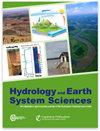Global dryland aridity changes indicated by atmospheric, hydrological, and vegetation observations at meteorological stations
IF 5.8
1区 地球科学
Q1 GEOSCIENCES, MULTIDISCIPLINARY
引用次数: 0
Abstract
Abstract. In the context of global warming, an increase in atmospheric aridity and global dryland expansion under the future climate has been expected in previous studies. However, this conflicts with observed greening over drylands and the insignificant increase in hydrological and ecological aridity from the ecohydrology perspective. Combining climatic, hydrological, and vegetation data, this study evaluated global dryland aridity changes at meteorological stations from 2003 to 2019. A decoupling between atmospheric, hydrological, and vegetation aridity was found. Atmospheric aridity represented by the vapor pressure deficit (VPD) increased, hydrological aridity indicated by machine-learning-based precipitation minus evapotranspiration (P − ET) data did not change significantly, and ecological aridity represented by the leaf area index (LAI) decreased. P − ET showed nonsignificant changes in most of the dominant combinations of the VPD, LAI, and P − ET. This study highlights the added value of using station-scale data to assess dryland change as a complement to results based on coarse-resolution reanalysis data and land surface models.气象站大气、水文和植被观测显示的全球旱地干旱变化
摘要在全球变暖的背景下,以往的研究预计未来气候下大气干旱度会增加,全球旱地会扩大。然而,这与观测到的旱地绿化以及从生态水文学角度看水文和生态干旱的显著增加相矛盾。本研究结合气候、水文和植被数据,评估了 2003 年至 2019 年气象站的全球旱地干旱度变化。研究发现,大气干旱度、水文干旱度和植被干旱度之间存在脱钩现象。以水汽压差(VPD)表示的大气干旱度增加了,以基于机器学习的降水量减去蒸散量(P - ET)数据表示的水文干旱度没有显著变化,而以叶面积指数(LAI)表示的生态干旱度降低了。在大多数 VPD、LAI 和 P - ET 的主要组合中,P - ET 的变化并不明显。这项研究强调了利用站点尺度数据评估旱地变化的附加价值,是对基于粗分辨率再分析数据和陆地表面模型结果的补充。
本文章由计算机程序翻译,如有差异,请以英文原文为准。
求助全文
约1分钟内获得全文
求助全文
来源期刊

Hydrology and Earth System Sciences
地学-地球科学综合
CiteScore
10.10
自引率
7.90%
发文量
273
审稿时长
15 months
期刊介绍:
Hydrology and Earth System Sciences (HESS) is a not-for-profit international two-stage open-access journal for the publication of original research in hydrology. HESS encourages and supports fundamental and applied research that advances the understanding of hydrological systems, their role in providing water for ecosystems and society, and the role of the water cycle in the functioning of the Earth system. A multi-disciplinary approach is encouraged that broadens the hydrological perspective and the advancement of hydrological science through integration with other cognate sciences and cross-fertilization across disciplinary boundaries.
 求助内容:
求助内容: 应助结果提醒方式:
应助结果提醒方式:


